Miller Park vs Busch Stadium – Milwaukee vs St. Louis
After a recent weekend trip to take in three Milwaukee Brewers games in St. Louis versus the rival St. Louis Cardinals, I spent a significant time reflecting on the differences (and similarities) between the stadiums each team calls home. Miller Park is located 3.2 miles from Milwaukee City Hall, while Busch Stadium is located 1/5th (0.2) of a mile from the iconic Arch. Miller Park has the roof, Busch Stadium has the view. Busch Stadium has the proposed Ballpark Village, Miller Park has its own sales tax. Miller Park has gameday bus service, Busch Stadium is located on a light rail line. And least important for the sake of this analysis, they each have their namesake beer. With all of that considered, which stadium does more for the city?
The comparison is worthwhile to make as the size of the St. Louis and Milwaukee markets are quite similar. Greater St. Louis has a 2007 estimated population of 2,871,421. Greater Milwaukee has a 2007 estimated population of 1,739,497. Missouri has an estimated population of approximately 5,900,000, and is home to the Kansas City Royals as well. The population of Wisconsin is estimated near 5,600,000. The markets are extremely similar in size when taking the state population into consideration. Furthermore, both stadiums are located in Midwest, making them subject to colder starts and finishes to the season than say the Houston Astros.
Stadium Location
Busch Stadium is located in downtown St. Louis. Almost every seat in the stadium has a view of a part of the skyline and the Gateway Arch. The stadium is currently bordered by a few surface parking lots, garages, and hotels. A few of those surface parking lots will become buildings as the mixed-use Ballpark Village is developed. There are numerous hotels within walking distance of the stadium, many closer than the surface lots of Miller Park. The St. Louis light rail system, Metrolink, runs right by the stadium with a stop conveniently labeled “Station” within a stones throw. I-64 is immediately adjacent to the stadium.
Miller Park is located three miles west of downtown Milwaukee along I-94. The stadium is surrounding on literally every side by surface parking lots, some stretching as far as a half mile from the stadium. If the roof is open, and you’re in the top level of the stadium, there is a chance you could catch a glimpse of the US Bank Center, the tallest building in Wisconsin. The nearest attraction is the Potawatami Casino, and there isn’t a hotel within walking distance. The 90 bus line runs from Downtown starting two hours before the game, but must contend with traffic waiting to park once it leaves Wisconsin Avenue.
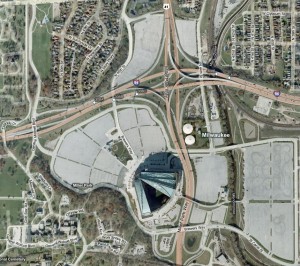
The amount of parking Miller Park requires because of the use of surface lots is really quite amazing.
Both stadiums are not the first iteration at their given location. County Stadium preceded Miller Park, and Busch Memorial Stadium preceded Busch Stadium.
Cost and Ownership
Busch Stadium had a final cost of $365 million when it opened in 2006. Of that cost, $45 million (12%) came from a long-term loan from St. Louis County. Private financing came in the tune of $90.1 million in cash from the Cardinals, $200.5 in bonds paid by the team, and $9.2 million in interest earned on the construction fund the Cardinals held. The stadium has a seating capacity of 46,861 and is owned by the St. Louis Cardinals. The stadium does not have a roof, or its own named expressway. I was unable to determine who paid for the cost overruns of $20.2 million.
Miller Park had a final cost of $400 million when it opened in 2001. The Brewers owners (led by the Seligs at the time) paid for 22.5 percent ($90 million). The taxpayers of Milwaukee, Racine, Waukesha, Washington, and Ozaukee Counties are still paying (with a 2014 estimated ending date) a 0.1% sales tax to cover 77.5% of the costs ($310 million). The stadium has a seating capacity of 43,000 and is owned in a partnership between the Southeastern Wisconsin Professional Baseball District (64 percent) and the Milwaukee Brewers (36 percent). The stadium features a fan-shaped retractable roof. The location of the stadium necessitates the construction and maintenance of Miller Park Way and the interchange with I-94, an expense I’m not sure is fully internalized in the cost of the stadium.
The most obvious difference between the two ballparks is the percentage of public financing. Busch Stadium was 12% taxpayer funded, Miller Park was 77.5%. Why was this? The biggest aspect appears to be the team’s ability to pay. The Cardinals had been banking money for years for a new stadium, while the Brewers, led by Bud Selig, did not have nearly the ability to pay what the Cardinals did. Ironically, the Brewers were able to obtain the retractable roof, despite having less money to start with than the Cardinals. The second most important factor in the funding for Milwaukee’s stadium appears to be the elected leaders, who were willing to go along with the Brewers plan (ultimately leading to a recall election and defeat for Senator George Petak of Racine).
A downtown stadium without a roof could have shaved at least $80 million from the sales tax burden, as the city could have offered TIF financing at least near $30 million and the retractable roof’s cost of $50 million would have been eliminated.
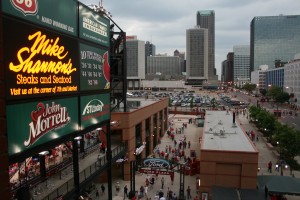
Busch Stadium has an open atmosphere that should work well with the neighborhood that develops around it.
Accessibility via Transit
As mentioned, Busch Stadium is next door to the Stadium Metrolink light-rail station, with connections to the airport, Illinois, and western St. Louis. The station platform is packed after games, but I was unable to find ridership figures or estimates for gameday traffic. The system itself handles about 60,000 riders a day. The station is located along a standard route, encouraging familiarity and predictability with taking public transit to the stadium. Unfortunately, a bus wasn’t anywhere to be found during my stay in St. Louis as a referendum was voted down in November and as a result bus service was reduced by nearly a third.
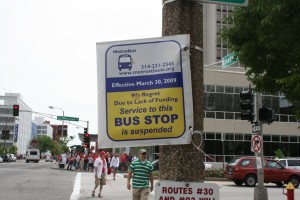
A sign announcing the cancellation of service to a downtown St. Louis bus stop. A frequent sight unfortunately.
In Milwaukee, the MCTS’s 90 bus route serves the bus starting two hours before the game. Having ridden both after a game, there are significantly more people waiting to take the Metro. The 90 bus only serves riders from downtown Milwaukee and along Wisconsin Avenue, unlike the St. Louis Metrolink line. The gameday-only nature of the 90 bus also is rather confusing to many riders who aren’t familiar with the route. The ride into the stadium is also far from smooth, as the bus must compete with stop and go traffic, from automobiles waiting to get into Miller Park parking lots, once the bus leaves Wisconsin Avenue. There are many times where getting out of the bus and walking from the edge of the parking lots would be much faster than waiting to get dropped off at the front doors.
Edge to St. Louis and Busch Stadium for frequency of service, quality of service, areas for rides to originate, off-bus ticketing (a problem on buses for visitors), and predictability/reliability of service.
Accessibility via Car
Both stadiums are readily accessible by car. Milwaukee is clearly more accessible by motor vehicle by virtue of the fact that there is nothing around it, making it ease for riders to find the one interstate exit to the stadium (conveniently labeled Miller Park Way). Busch Stadium is served by multiple exits, but the large number of one-way streets in downtown St. Louis seem to induce rush hour congestion where none needs to be. Overall, the traffic flow near Busch Stadium, despite the massive amount of pedestrian traffic, seems to flow just fine.
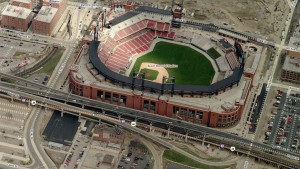
Ballpark Village will be built at the top of this image, just north of the stadium. Despite the presence of the interstate immediately next to the stadium, Busch Stadium seems less car-orientated than Miller Park.
Spillover Effect
What does each do for businesses, both nearby and far away?
Busch Stadium provides obviously a large boost for the hotels in the surrounding area, perhaps more measurable than Miller Park because of the immediate proximity. There are also numerous vendors selling goods outside the stadium, something you don’t see at Miller Park. On the flip side, grocery stores across the state of Wisconsin benefit marginally from the food sales generated by tailgating.
Numerous Brewer fans end up on Water Street and Bluemound Road after games, but not in the numbers that Cardinals fans show up in Laclede’s Landing to drink their In-Bev beers.
Perhaps the most disappointing aspect of Busch Stadium was the lack of restaurants near the stadium. There were a couple, but not in the number I would expect an urban stadium to bring. Nothing like what is visible at Wrigley and Fenway. Ballpark Village will hopefully ignite a process that brings a large amount of street level retail to the area.
Parking is the biggest difference between the two. At Miller Park almost every parking stall by the stadium is controlled by the Brewers and your money goes directly into their coffers. In St. Louis, a wide diversity of ownership is present near the stadium. The result? A diversity of pricing options, and light competition that works to keep prices down somewhat. Similar to how things are with the Bradley Center in Milwaukee.
The real upside to Busch Stadium’s parking setup is that the stalls can be used for more than one purpose. At Miller Park the surface parking lots are exclusively for stadium activities. At Busch Stadium, the parking can be used for many purposes.
Tailgateability
Coining a new term specifically for this article, “tailgateability” is the measure of the ease of eating out of the back of your car an area provides. Miller Park wins, but really not by a lot. At Miller Park, you can fire up your grill at any parking stall, in St. Louis this is possible for a lot of the spots, but far from all of them.
This brings up an important point though, is tailgating possible at urban stadiums? Certainly it is. There is no reason why the roofs of parking garages and select surface lots couldn’t be sold at a small premium to tailgaters. In Milwaukee shuttles could run between numerous areas like the lakefront parking lots and Summerfest lots to accommodate even more tailgaters. Also, grills could be installed and public plazas could be constructed (or actually used) that would accommodate tailgaters.
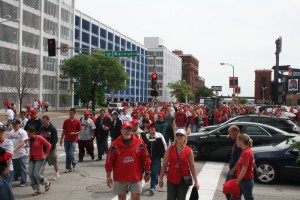
Fans take to the streets after games in St. Louis as the street grid distributes them across the city. Cars are more confined to a lot of one way streets.
Conclusion
Each stadium has features that make it an enjoyable place to watch baseball. The roof at Miller Park is nice, but was the $50+ million price tag worth it? You could argue each way.
The location of Busch Stadium is much more enviable than that of Miller Park and leads to a number of efficiencies. It’s underdeveloped at this point though, Ballpark Village’s development is a must. St. Louis has a great asset in the stadium, and a fair number of buildings nearby that work well with it. Adding more mixed-use buildings nearby will greatly improve the downtown and build a true 24-hour neighborhood.
The fact that so little of Busch Stadium was paid for with taxpayer dollars is a plus. Having a winning culture that sold tickets and a slightly bigger fan base helped put the team in that position though. Consequently though, it did appear that every piece of food at the stadium cost a dollar more. Pick your poison, although I’m sure most would choose the private funding.
Building Miller Park in downtown Milwaukee was studied (drawings included below), but there was likely a hidden cost to that. Would Milwaukee have been to eliminate the Park East Freeway if the stadium was to be near the end of the freeway stub? Probably not. Suburban opposition to such a proposal would have been a lot stronger.
At the end of the day, not building the new stadium in downtown Milwaukee was certainly a missed opportunity. The only beneficiary of its current location is the Brewers themselves. But was it something that downtown Milwaukee needed desperately? No, it’s pretty clear it wasn’t. Milwaukee did miss out on a chance to accelerate all the good things going on in or near downtown though.
Miller Park Downtown
From Thursday Architects…
This project was commissioned by the City of Milwaukee as a background study in hopes of persuading the owner of the Milwaukee Brewers to locate his new publicly funded ballpark downtown rather than on the suburban fringe of the city. Promoted without success by a New Urbanist Mayor, the City proposed the demolition of a freeway spur on the north side of downtown, and the location of a new ballpark along the edge of the Milwaukee River as part of new neighborhood development at the northern edge of downtown. Parking was to be accommodated by new and existing lots and garages dispersed throughout the downtown area and immediate environs. The Brewers’ owner wasn’t buying it; and the $500M “Miller Field” will open this season in a 20,000-car parking lot west of Milwaukee.


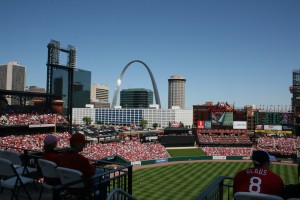
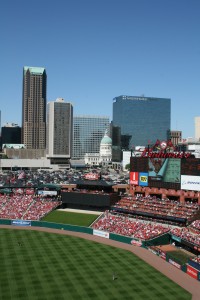
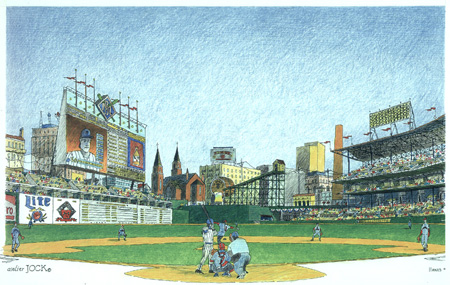
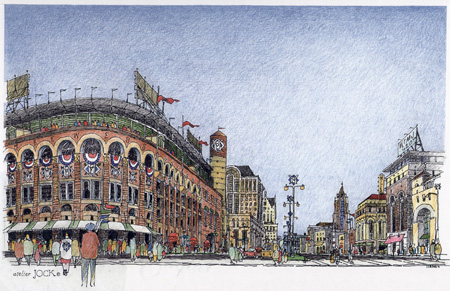




















The sight lines at Miller Park are great, but you never get the feeling your watching a game outside even when the roof is open. The biggest mistake Selig made was to name the team after Milwaukee. If he wanted a statewide fan base he should have called them the Wisconsin Brewers.
I’ll take the roof anyday. Milwaukee is cold.
I wonder what might have been with a downtown stadium, though I think expecting tailgaters to do their business at a random parking lot (summerfest) and then take a shuttle to the stadium is a stretch, that scheme shatters the connection between tailgating and the Brewers/stadium that we all know and love. Downtown would be a bit better served if the Bucks were relevant, if they’re still in Milwaukee longterm.
Wisconsin Brewers??? The Brewers don’t have a statewide fanbase? The Crew are the only game in the State, if people don’t follow them they must not like baseball. The Brewers’ ticket sales are fantastic and the team brings a lot of pride and a dash of togetherness to Milwaukee.
Great post, Jeramy!
I believe one of the underlying reasons for locating Miller Park out west was because Selig felt there wasn’t a viable transit system in place in order to move it downtown. That’s too bad because the drawing of a Water St. location will probably look like the better option to most people in a few years, if it doesn’t already. I can appreciate and enjoy our tailgating culture — I think it was a huge factor in selling Miller Park’s sales tax to a very skeptical public — but, like you mention, it’s economic benefit is tiny and it’s well on its way to becoming obsolete.
I can’t see tailgating becoming obsolete in Milwaukee anytime soon, it’s somewhat unique to Wisconsin and is a proud piece of our identity. It brings utility to a lot of people well beyond the mere secondary economic impact provided to grocery stores, and economic development is only a means designed to increase utility right? I’m also not sure the secondary benefits are marginal, simply stating that doesn’t do. Purposely conservative numbers: 15,000 people x $5.00/game x 50 games = $3.75 million. It someone looked at how many people tailgate, how much food and drink they consume, and what sort of other purchases (grills, chairs, apparel etc) are made as a result of preparing to tailgate, I wonder what the numbers would actually be.
In any event, I would have liked the idea of rooftop tailgating and public plazas/parks near a downtown stadium to give the tailgaters something. Probably a tougher sell in re the sales tax, but there was always the Potawatomi casino/stadium option if we’re willing to have gambling downtown. Milwaukee missed a great opportunity, but at least they managed to keep the Brewers in Milwaukee and build a beautiful if poorly located stadium in the process.
Good points, Nate! I didn’t mean to imply that tailgating sucks, just that as gas prices increase less utility will be derived from car-based activities, especially one that can be easily accomplished without the use of a car and/or surface parking lot. There’s definitely an economic impact to tailgating and I wish I knew how large it really is, but if we had a downtown stadium with no surface parking lots I would imagine that our midwestern ingenuity would prevail and we’d find a new way to tailgate. Perhaps a greater density would inspire a larger and more effective beer bong 🙂
Also, those pictures of a downtown Miller Park are sad to look at now. We really missed an opportunity to grow the downtown.
The benefits of a downtown stadium are numerous, no doubt. But there are other issues at play here.
First of all, those renderings do not convey the massive scale at which a modern stadium must be built. They appear to be more of an old-timey field, without any amenities, along the lines of an Ebbets Field. The economics of building such a stadium without those revenue-producing amenities simply do not work. Additionally, a construction project of this magnitude would require much more space than is available. If that is the spot, most of those buildings would need to be demolished. There would be an enormous cost of property acquisition and demolition on top of construction.
I don’t understand the comment on how taking off the roof at a downtown stadium would cut the price tag. The location of the stadium has nothing to do with having a roof, which is a necessity in this lovely Milwaukee climate. When the Twins are playing their home games in Milwaukee next April, you will see the benefits of a roof.
Another issue that nobody mentions is that of what would happen to the existing infrastructure if the stadium location were to be moved? The surface parking lots and the stadium interchange were already there, moving the stadium wouldn’t make them disappear. What would be built at this site instead? Answer: probably nothing for a very long time. This is an excellent example of infill development, only on a much grander scale. Would the Menomonee Valley revitalization have happened without Miller Park? Maybe, but probably not as successful, and certainly not as quick. Would Canal Street have ever been extended? Would the Hank Aaron State Trail have been developed around the area? The stadium at this location was an absolute catalyst for many of these projects.
As far as tailgating goes, yes it would continue no matter where the location. No, it would not be as massive if lots were scattered. What is more likely is what you see around Camp Randall. Outdoor tent areas sponsored by local bars, with a mixed amount of individual tailgating. Fun, but nothing like the unique culture generated by tailgating at Miller Park.
Milwaukee is a large urban city. Not everything can or should be located in one central area. I just came back from the recent series in Minnesota and there is practically NOTHING near that downtown stadium.
Right on, Erik. Instead of bringing Miller Park to the destination (downtown), they kept it as it’s own destination area and I think that’s a good thing. I am a big fan of ballparks right in the heart of the city because of the views, but I love that Miller Park is where it is. Great point about tailgating at Camp Randall vs. Miller Park….the enormous lots enable people to interact with each other that a downtown location just wouldn’t provide. Also, I’m sure you’re right that there would’ve have been massive fees in land acquisition and demolition had it been built downtown. I also agree that it has improved that side of the Menomonee Valley quite a bit. All of those buildings at the edge of the Mets and Dodgers parking lots (with continuing construction) weren’t there 8 years ago.
Miller Park sets itself apart from many other stadiums across the country because it isn’t surrounded by anything else of much importance, other than thousands of happy tailgaters before a game. It never gets old to drive past it on I-94, and it’s position off the interstate makes it an absolute icon that you can’t miss if you’re coming to Milwaukee from the west. It’s a sort of mecca for Brewers fans, our own “little” area that is solely dedicated to baseball and nothing else. I think it’s pretty damn cool.
First, I really don’t get where you make the St. Louis vs. Milwaukee metro comparisons. I know the MO vs. WI comparisons are close, but the St. Louis metro is about 65% larger than the Milwaukee metro, and I’m not quite sure they can draw the same conclusions. Personally, for almost every game I’ve gone to I’ve taken the 15 Oakland bus to WI ave, then the 90 to Miller Park. If you’re a UWM student (as I was) this is FREE!!!! with the UPASS!! Seriously, the best way to get to and from games. For the times I’ve driven there, getting out and home is the worst.
Also, although I’m not against a train transit system, it was a heck of a lot cheaper to build a stadium with a roof on with taxpayer funds than it would be to build a light rail system connecting multiple areas with Miller Park being a stop.
One HUGE oversight in this article is that Ballpark Village in St. Louis does not exist. It is not real. I personally, without any architecture experience, could draw a few cool looking buildings that could be build around Miller Park for $600+ million.. but the fact is that these buildings, like Ballpark Village, are not standing, are not going to be funded in the near future, and under current circumstances may not be built for a long while. I don’t get how you justify even mentioning Ballpark Village in this article being a factor, as it exists only on paper. Right now, according to the Cardinals, the area is being used for a softball field and Parking.
Another thing that keeps bothering me is good old Detroit. I mean with Busch stadium, they (like most others.. and us) built the new stadium next to the old one. But the Tigers didn’t do that. In fact the Lions and Tigers (and, in the vicinity is rumored to be the the site of a new Redwing’s stadium) have completely bulldozed an entire swath of their downtown to accommodate their new stadium row. I know downtown Milwaukee is not a direct comparison to downtown Detroit, but I really want to know how much it helped relocating the Tiger’s stadium from Corktown to Downtown, and I would like to make some sort of comparison as to how exactly it would benefit Downtown by relocating the Brewers there from their current (old) location.
And that brings up Downtown Milwaukee’s impact. Which swath of Downtown buildings are you willing to crush in order to build a Miller Park-like stadium downtown. No piece of land that large is unoccupied along the Milwaukee River. And that cute old-school stadium looks nice and would be cool if it would have been build about 80 years ago, but nobody would build it today unless it was economically viable today.
Yes, I like Miller Park the way it is, and although some stadiums are built right in their downtown area’s, ours isn’t, and hasn’t been since perhaps Borchert Field sat where I-43 sits now. It’s hard to imagine downtown with a Miller Park-like ballpark. What it would gain from it and what it would lose for it to happen could be one long discussion. Thankfully, the “Thursday Architects” were wrong, and Miller Park didn’t open west of Milwaukee. They opened on 1 Brewers Way IN Milwaukee. I know countless fans who wouldn’t have it any other way. 25 games into this season, and we’ve got the 9th highest avg attendance of any major ball park, including a higher ballpark utilization percentage than St. Louis (88.2 vs. 86.3), and it really seems that it eventually comes down to how large the stadium is itself and how good the team that plays in it is more than where it is and how many transit stops are by it.
I’ve often thought about how Milwaukee blew it by building Miller Park where it is, especially when I go by all the ugly empty lots in our downtown. It’s just one more example of our sprawling city’s neglect of the downtown and proximity to a beautiful lake.
Kevin K also brings up many valid points. The main article was written with an obvious bias… which is too bad considering Milwaukee is already dealing with an image crisis. The author takes his time slamming Miller Park, but gives only cursory attention to its highlights.
The roof serves an incredibly useful purpose given our climate – ask Cleveland. The roof also makes the stadium a year round venue.
Tailgating is also overlooked. It was a major consideration in determining the current location. The idea of tailgating in a structure is, frankly, foolish. The glaring exposure to liability, alone, is cost prohibitive.
Finally, the author ignores the fact that the Menomonee Valley is being redeveloped and that there are discussions currently going on to create attractions to compliment Miller Park. I have it from at least one reliable source that the Brewers are researching new methods to generate revenue once the stadium is paid off.
So next time a side by side comparison between cities is made, do not just cite the “City X Tour Guide.” Some balanced reporting would be appreciated.
I can also confirm that the Brewers are looking into various possibilities, including mixed use developments, for the land surrounding the stadium. Seeing as the Ballpark Village around Busch Stadium is just a proposal, it should be considered equal to these proposals, some of which are of a similar nature.
Sooo, pick up and move Miller Park to the lakefront???! that would be sweet
First of all those renderings aren’t anything to get all excited about those are about as rough as they come! I personally can see the argument on both sides, Miller Park being built in the up and coming park east freeway land would have obviously been a good thing but you know what all those bars run shuttles to and from the game anyways and downtown Milwaukee is really holding its own even without Miller Park, spread the wealth around i say! We could debate this all day but the new Miller Park REALLY helped out the Menomonee Valley which has had a great comeback with a clean, safe look, and new companies moving in. And you can’t tailgate in the city to the same extent and what do we want all that vacant land for parking? Even if it was only for 10,000 cars alot more surface lots would be around!
I have never heard anyone complaining about how the stadium should have been downtown as strangers and friends alike chug down beers and brats while playing catch in the parking lot getting amped up for the Brew Crew and from being south of the border in IL and bringing friends that stadium is raved about by cubs/whitesox fans alike who wish their stadiums were even close to Miller Park! What an atmosphere and the stadium turned out quite well i must say!
Bud Selig is a crook! You folks should lead the effort to impeach that SOB! His greed and stupidity is killing baseball and holding cities hostage to build new stadiums or killing the family tradition with high costs and threats to physically relocate teams – he should be put on death row!
His statement that St. Louis would not be in the running to host an all-star game anytime soon unless a new stadium was built is one of many examples of his poor leadership. George Bush was next in line to become commissioner BIT Bud made up his own rules and ignored Bart G’s dying wishes. Therefore all teams will have new stadiums payed by hard working tax payers, ballgames ending in a tie, globalization of America’s pastime, steroids, and tainted records! Oh yea – and baseball minded presidents! 🙂
There was a reason why Milwaukee County Stadium was originally built in the valley in the early 1950s-it was central to the entire county. Freeways containing mass transit were to be built both east-west and north-south of it (unfortunately, only one of those happened). The Zeidler Administration could not find a suitable location within the city and was not willing to expend the political capital to clear the land necessary for such a project (Frank told me that while he was alive). Like the freeways, Frank was happy to have the County take the lead on this project. Those reasons are equally valid today as they were in 1950. Also, the city proposal to have the stadium put on Park East land (why tear down a freeway to put a stadium on it?) happened too late. Norquist had years to make the proposal but didn’t. Only near the end did he suggest it. So, criticism should be directed at him if people are going to blame Bud Selig. In the end, though, the current location is the best one.
Jim, I believe you’re taking that history out of context.
As for why the county was handed off so many responsibilities, such as the zoo, park system, freeways, and the stadium had less to do with the competance of the county, but that it functioned as a de-facto metropolitan government. This was the logical course at that point in history, but two generations later the same rationale would dictate moving responsibilites from the county to a defacto or dejure metropolitan entity.
Also, Frank Zeidler believed in an anti-urban policy to deconcentrate the metro in response to the nuclear threat of the 1950’s. Since the city destroying bombs of today were yet to be invented, the idea was to spread the city out, so any strike would merely decimate and not obliterate a city.
Now, I’m not necessarily judging him, but you have to understand the motivations and ideas that were in mind. Mayor Zeidler did some great things for this city, but we can’t look to him for urban policy.
That said, why would Norquist put up a proposal for a new ballpark Downtown, years before the Brewers are talking about moving? That’s political suicide if I ever heard it. The idea for a Downtown stadium was never fully considered for a lot of reasons and I would place my money on many people’s sheer resistance to change.
The gateway arch is really an impressive building. Especially the elevators are awesome. I really recommend everybody to check it out.
UPDATE – On April 6th, St. Louis County voters overwhelmingly passed Proposition A, which restores all service cuts and will expands the system! You won’t see those “suspended” service signs for long.
the people of milwaukee want to tailgate…that is why it is not downtown…sure it would be cool to have a stadium near the bradley center and the heart of downtown but that parking lot atmosphere is half of the experience.Lets just hope the Bradley Center gets replaced in that vacant area the freeway use to seside in by the old pabst brewery since that area is rather depressing considering what it all used to be (and I should know I drive it every day).